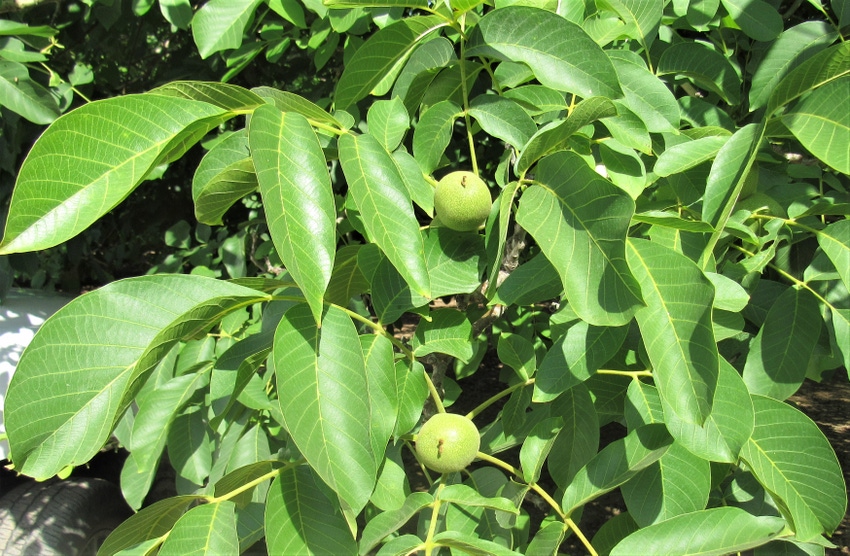
Sporadic damage that has developed in the canopy of many walnut orchards and at least in one pistachio orchard in California’s mid-valley region has been a perplexing mystery to researchers and University of California Cooperative Extension (UCCE) advisors in the field since signs of damage emerged in late March and early April.
That’s when canopy damaged was noted following bloom and early leaf-out in both young and mature blocks of nut trees that began showing signs of possible freeze damage.
“I have been working some 38 years here [in the Valley] and I remember seeing winter freeze damage in young trees before. It is not unusual, even expected with an early autumn frost to see damage on one, two or three-year-old trees. But what I have never seen before that I can remember was the kind of damage we have been seeing on mature trees,” said Janine Hasey, Tree Crop Farm Advisor and County Director in Sutter, Yuba and Colusa Counties. “After the freeze event we experienced in early November we have been seeing canopy damage with spring’s arrival in eight-year-old, 10 and even 14-year-old trees.”
Hasey said that may not be unusual following hard winter freeze events, but very strange as a result of early autumn freezes.
UCCE Area Sustainable Orchard Advisor Luke Milliron in Butte County recently doubled down on the mystery.
“We started looking at other contributing factors that could have caused the kind of damage we were seeing. We consulted with other UC researchers and visited a number of orchards that were experiencing the problem in hopes of uncovering the cause or causes,” Milliron reported.
To further complicate the mystery, farm advisors investigating the incident reported sporadic and variable damage occurred in areas within some blocks that were surrounded by healthy blocks of trees that demonstrated no signs of freeze damage.
He said they looked at orchard practices that may have contributed to the problem and other factors like carbohydrate levels in the damaged areas of blocks where trees were showing stress.
“After looking at more and more orchard blocks that were showing similar damage across county lines we realized that whatever the cause, it was affecting trees regardless of maturity, from young trees to full-bearing trees, something I had never seen from an autumn freeze,” Hasey added.
But after several weeks of research involving several UC advisors and researchers, Hasey says they have come to the conclusion that extreme temperature swings from day-time highs to night-time lows may be the primary reason for the nature of the curious damage.
Event was unusual
She said she still defines the event as ‘unusual’ because even during a hard winter freeze event most trees that suffer serious damages are trees that were already stressed for one reason or another. But in this latest incident, she was finding even healthy trees were subject to damage. She said researchers cannot say with certainty there were no other factors involved.
“We looked at a number of possibilities including the amount of heavy rain we received following a dry autumn and how that might have played into an early freeze,” Milliron noted.
“Coincidence or not, in my area the first freezing temperatures we experienced was the night after the Camp Fire erupted on Nov. 8, so we had to look hard at that as a possible contributing factor,” Hasey said.
She did note another contributing factor to the freeze event may have been many of the orchards that demonstrated tree damage in the spring had not received significant rains or irrigation for 30-45 days prior to the November freeze.
“In at least one case, an orchard just across a dirt road from one of the orchards that suffered freeze damage didn’t show any damage at all, and that orchard had received irrigation water in the days leading up to the event. So if the damaged orchards were to have received water leading up to that first freeze, they might not have had as much damage,” she offered.
In the end, however, Hasey says the prevailing conclusion is that extreme swings in temperatures over several days and nights in early November are mostly consistent with the types of damages they discovered in April.
As with other autumn freeze events, Hasey says they are seeing some recovery in the canopies of damaged trees now and are recommending that orchard operators treat the incident as a freeze-damage event.
“Some dead wood has been cleared from trees with the most damage, but we are recommending that growers delay extensive removal at least until mid-summer, allowing enough time for natural recovery efforts,” she added.
She also warns about adding nitrogen to soil around damaged trees and says less water will be needed on damaged trees. She also warns that as a result of damaged canopies, growers may want to do sunburn damage control on the trunk such as whitewash on southwest exposed areas that will get direct sunlight. She also advises growers to watch for bot damage and remove any pruned wood completely from the orchard to avoid additional bot contamination.
On the day we visited with Hasey she had just attended a special event commemorating her 38 years of service. While she says the freeze event of last November has nothing to do with her retirement, she said it will be a memory she will carry forward with her.
“I won’t be working everyday but I will remain active within the system as an emeritus advisor, and as a writer and researcher and will still be involved in various aspects of the tree nut industry. I won’t be county director any longer, but I won’t be totally removed from the industry either.”
And that is good news for tree nut farmers in the California valleys.
For more news on tree nuts as reported by growers and farm advisors, subscribe to the Tree Nut Farm Press e-newsletter.
About the Author(s)
You May Also Like






